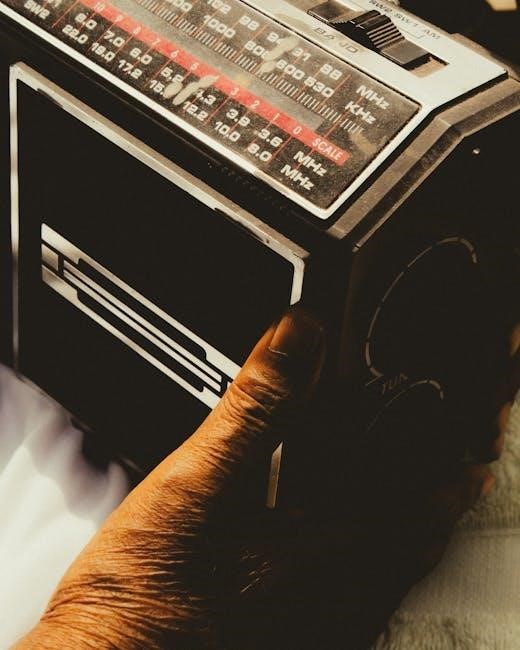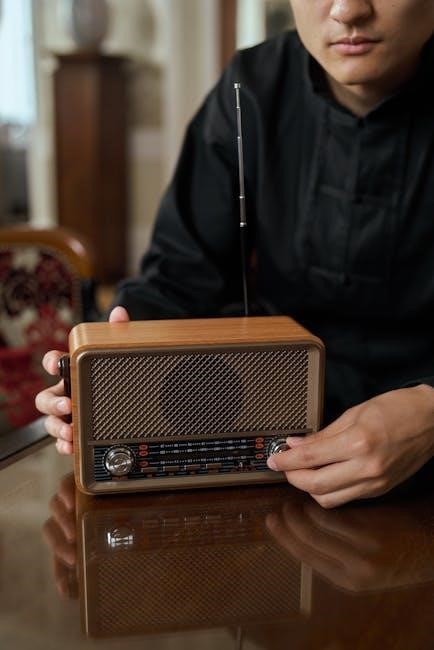midland weather radio manual wr-120
The Midland WR-120 is a reliable NOAA weather radio with S;A.M.E. technology, providing critical alerts for weather and civil emergencies. It features color-coded indicators and a loud siren for immediate notifications, ensuring user safety. Compact and versatile, it’s ideal for home, emergency kits, or outdoor use.
1.1 Key Features of the WR-120
The Midland WR-120 boasts an array of essential features, including S.A.M.E. (Specific Area Message Encoding) technology, which allows users to receive location-specific emergency alerts. NOAA weather alerts provide real-time updates on severe weather conditions, ensuring timely notifications for safety. The radio also supports over 80 emergency alerts, such as Amber alerts, tornado warnings, and civil emergencies. Additional features include color-coded indicators for alert levels, a loud alert siren, and customizable settings for tones and languages. Its compact design makes it ideal for home or portable use, while the clear display and intuitive controls enhance user experience. These features combine to make the WR-120 a reliable tool for staying informed during critical situations.
1.2 Importance of NOAA Weather Radios
NOAA weather radios, like the Midland WR-120, play a critical role in emergency preparedness by providing immediate, reliable alerts during severe weather events. They are essential for areas with limited internet access, ensuring continuous updates on life-threatening conditions such as tornadoes, hurricanes, and floods. The WR-120’s ability to receive NOAA alerts makes it a vital tool for staying informed and safe. These radios are a cost-effective way to protect families and communities, offering timely warnings that can be life-saving. By providing real-time information, NOAA weather radios empower individuals to take necessary precautions, making them indispensable for both urban and rural residents.
1.3 Overview of S.A.M.E. Technology
S.A.M.E. (Specific Area Message Encoding) technology allows users to receive emergency alerts tailored to their specific geographic area. This feature filters out unnecessary alerts from other regions, ensuring only relevant warnings are delivered. The Midland WR-120 uses S.A.M.E. to provide precise notifications for weather events, Amber Alerts, and civil emergencies. By programming a FIPS code corresponding to the user’s location, the radio delivers targeted alerts, reducing false alarms. This technology enhances safety by ensuring timely and accurate emergency information, making it indispensable for areas prone to severe weather or other hazards. S.A.M.E. technology is a cornerstone of modern weather radios, offering reliability and customization for critical situations.

Unboxing and Initial Setup
Unbox the Midland WR-120, which includes the radio, antenna, and manual. First, turn it on, set the time, and extend the antenna for optimal reception. Follow the quick start guide for initial setup and configuration to ensure proper functionality.
2.1 What’s Included in the Box
The Midland WR-120 box contains the weather radio, a telescopic antenna, a power adapter, and a comprehensive owner’s manual. Additional accessories may include a battery compartment for optional battery operation. The radio itself features a sleek, compact design with a clear display and easy-to-use controls. The manual provides detailed instructions for setup, programming, and troubleshooting. Ensure all items are included before proceeding with the initial setup. The antenna is essential for optimal reception, and the manual is crucial for understanding the device’s features and operation. This setup ensures you’re prepared for reliable weather alerts and emergency notifications right out of the box.
2.2 First-Time Power-On Instructions
Upon first power-on, the Midland WR-120 will prompt you to configure essential settings. Ensure the antenna is fully extended for optimal reception. Locate the ON/OFF switch on the right side and move it to the ON position. The display will illuminate, and you may see the NOAA logo or “NOAA” text appear. If using AC power, plug in the adapter. For battery operation, insert the required batteries; The radio will automatically enter setup mode, guiding you through time, date, and location settings. Follow the on-screen prompts to complete the initial configuration. Properly positioning the antenna is crucial for clear signal reception. Once powered on, the radio is ready to receive weather alerts and emergency notifications.
2.3 Setting Up the Antenna for Optimal Reception

For optimal reception, position the Midland WR-120’s antenna in a high, unobstructed area, such as a shelf or near a window. Adjust the antenna’s orientation by rotating it to enhance signal strength. In urban or obstructed environments, consider using an external antenna for improved clarity. Ensure the antenna is fully extended and free from interference. Test signal strength after adjustments and consult the manual for specific tuning tips to maximize your radio’s performance and ensure reliable weather alerts.

Configuring the WR-120
Configure the WR-120 by setting the time, location using S.A.M.E., and language. Adjust volume and tone settings for optimal alert notifications and clear audio output.
3.1 Setting the Time and Date
To set the time and date on your Midland WR-120, press the MENU button until the time display appears. Use the UP and DOWN arrows to navigate to the “Set Time” option and press SELECT. Choose your time zone using the arrow keys and confirm with SELECT. Next, set the hour and minute by scrolling with the arrows and saving with SELECT. Repeat the process for the date, selecting the month and day. The radio automatically updates for daylight saving time, ensuring accuracy. Proper time setup is essential for receiving timely weather alerts and alarms. Follow these steps carefully for accurate time and date configuration.
3.2 Programming Your Location with S.A.M.E.
Programming your location using S.A.M.E. (Specific Area Message Encoding) ensures you receive weather alerts relevant to your area. Press the MENU button and scroll to “Set Location,” then select your country. Enter your FIPS (Federal Information Processing Standards) code, which identifies your county, using the numeric keypad. You can store up to 6 locations for broader coverage. Once entered, save the settings. This customization guarantees you only receive alerts for your selected areas, enhancing safety and relevance. Ensure the codes are accurate for proper functionality. S.A.M.E. technology is key to receiving timely, localized emergency notifications. Always test your settings to confirm correct operation. This step is crucial for optimal performance of your Midland WR-120 weather radio.
3.3 Selecting the Language
To select the language on your Midland WR-120 weather radio, navigate to the MENU and scroll to “Set Language.” Use the arrow keys to choose from available options, such as English, Spanish, or French. Once selected, press the MENU button to save your preference. The radio will display all alerts and information in the chosen language. This feature ensures clarity and accessibility for users who prefer non-English notifications. The default language is English, but customization allows for a personalized experience. After selecting, test the radio to ensure the language settings are correctly applied. This step is essential for understanding alerts and emergency instructions clearly. The WR-120 accommodates multilingual users, enhancing its versatility for diverse households.
3.4 Adjusting Volume and Tone Settings
To adjust the volume and tone settings on your Midland WR-120 weather radio, navigate to the MENU and scroll to “Volume” or “Tone.” Use the arrow keys to increase or decrease the volume level. For tone settings, select from options like “High,” “Medium,” or “Low” to suit your preference. Press the MENU button to save your settings. The volume control ensures clear audio during alerts, while tone settings allow customization for optimal listening comfort. Additionally, the WR-120 features a separate volume control for emergency alerts, ensuring critical messages are audible. Adjusting these settings enhances your user experience and ensures you stay informed during weather events. Proper calibration is essential for both everyday use and emergency preparedness.

Operating the WR-120
Operate the WR-120 by monitoring weather conditions, navigating the menu, and utilizing alarms. The display icons indicate active channels, while NOAA updates keep you informed. Reliable and easy to use.
4.1 Navigating the Menu System
Navigating the WR-120’s menu system is straightforward. Use the “Menu” button to access settings like time, location, and language. The “Up” and “Down” arrows scroll through options, while “Select” confirms choices. The display shows clear icons and text, guiding users through adjustments. Color-coded indicators provide visual feedback for active settings. The system is intuitive, allowing users to quickly customize alerts, tones, and channels. Emergency alerts are prioritized, ensuring critical information is displayed immediately. The menu is user-friendly, making it easy to personalize the radio for specific needs. This setup ensures efficient operation during both routine use and emergencies.
4.2 Tuning into NOAA Weather Channels
Tuning into NOAA weather channels on the WR-120 is simple. Turn the radio on and extend the antenna for optimal reception. Press the “Weather/Snooze” button to cycle through the seven pre-programmed NOAA channels. The display will show the channel number and signal strength. Use the “Up” and “Down” arrows to manually adjust the channel if needed. The radio automatically prioritizes emergency alerts, ensuring critical updates are received immediately. Color-coded indicators will flash to signal the type of alert. For better reception, ensure the antenna is fully extended and positioned away from obstructions. The WR-120’s S.A.M.E. technology ensures you only receive alerts relevant to your programmed location, making it a reliable tool for weather monitoring.
4.3 Understanding the Display Icons

The Midland WR-120 features a clear display with icons that provide quick status updates. A flashing red light indicates an emergency alert, while amber signals weather alerts. Green means non-weather civil alerts, and steady red indicates a test or no alert. Signal strength bars show reception quality, and icons display time, alarm status, and battery level. These visuals help users immediately grasp the situation without detailed menu navigation. The color-coded system ensures alerts are easily distinguishable, while additional icons like the antenna and channel numbers provide essential operational feedback. This intuitive design makes the WR-120 user-friendly, even during stressful situations. The display icons are a key feature that enhances the radio’s functionality and user experience.
4.4 Using the Alarm and Snooze Functions
The Midland WR-120 allows users to set up alarms for weather alerts and emergencies. When an alert is received, the radio activates an audible siren and flashes its LED indicator. Pressing the Snooze button temporarily silences the alarm for a few minutes. The alarm can be programmed to sound for specific alert types, ensuring you stay informed about critical situations. Customizable volume and tone settings let you adjust the alarm to suit your preferences. The snooze feature is particularly useful during nighttime or when immediate action isn’t required. This functionality ensures you receive timely notifications while maintaining control over alert disruptions, making the WR-120 a practical tool for emergency preparedness. The alarm and snooze functions are essential for staying safe and informed during severe weather events.

Advanced Features
The Midland WR-120 offers advanced features like emergency alerts for tornadoes, hurricanes, and Amber alerts. It includes a loud siren and color-coded indicators for urgency. Users can customize alert types and tones for personalized notifications, enhancing emergency preparedness.

5.1 Setting Up Emergency Alerts
Setting up emergency alerts on the Midland WR-120 ensures you receive critical notifications for life-threatening weather events and civil emergencies. Using S.A.M.E. technology, you can program the radio to receive alerts specific to your area. The WR-120 supports over 80 emergency alert types, including tornado warnings, Amber alerts, and hazardous material spills. To set up emergency alerts, navigate to the menu, select “Emergency Alerts,” and choose the types of alerts you want to receive. You can also customize the alert tone and volume to ensure notifications are clear and attention-grabbing. Once configured, the radio will automatically sound an alarm and display the alert message during an emergency, providing vital information to keep you and your family safe.

5.2 Using the S.A.M.E. Technology
Using S.A.M.E; (Specific Area Message Encoding) technology on the Midland WR-120 allows you to receive emergency alerts tailored to your specific geographic area. To set it up, first, identify your local NOAA weather radio frequency and tune the radio accordingly. Next, locate the S.A.M.E. code for your county through NOAA or emergency management resources. Enter this code using the radio’s keypad, typically found under the menu option for S.A.M.E. setup. The radio will then filter alerts to only those relevant to your area. For multiple regions, you can input additional codes if supported. The radio continuously monitors frequencies for alerts with your programmed codes, notifying you with alarms or visual cues. Regular testing ensures functionality, and troubleshooting options like error messages or resetting codes are available if issues arise. This feature enhances the radio’s effectiveness in providing timely, area-specific emergency notifications, crucial for preparedness and safety.
5.3 Customizing Alert Types and Tones
The Midland WR-120 allows users to customize alert types and tones to suit their preferences. You can enable or disable specific alerts, such as tornado warnings or Amber Alerts, through the menu system. Additionally, the radio permits tone customization, enabling selection from a range of alert tones or adjusting volume levels. This feature ensures you receive notifications that matter most without unnecessary disturbances. For enhanced clarity, the radio also includes color-coded indicators to visually reinforce alert types. By tailoring alerts and tones, users can optimize their experience, ensuring critical notifications are both audible and visible, thereby enhancing preparedness and safety in emergency situations.
5.4 Utilizing the Color-Coded Indicators
The Midland WR-120 features color-coded indicators that provide visual cues for different alert types and statuses. These indicators enhance user experience by offering quick, at-a-glance information. For example, a red light may signify a critical emergency, while orange could indicate a severe weather alert. Green might show normal operation, and yellow could denote a standby or low-battery status. These visual signals complement the audio alerts, ensuring users are immediately aware of the situation. The color-coded system is especially beneficial for those with hearing impairments or in noisy environments. By leveraging these indicators, users can quickly assess the urgency and type of alert, enabling faster decision-making during emergencies. This feature adds an extra layer of safety and convenience to the radio’s functionality.

Maintenance and Troubleshooting
Regularly clean the antenna for optimal reception and check power sources. Troubleshoot issues like no sound by resetting or updating firmware, ensuring reliable operation during emergencies.
6.1 Regular Maintenance Tips
Regular maintenance ensures optimal performance of your Midland WR-120. Clean the antenna periodically to remove dust or debris, which can interfere with signal reception. Check the power sources, including batteries and AC adapters, to ensure they are functioning properly. Update the firmware regularly to access the latest features and improvements. Store the radio in a dry, cool place to prevent damage from moisture or extreme temperatures. Additionally, perform a factory reset if the device malfunctions, as this often resolves software-related issues. By following these tips, you can extend the lifespan of your weather radio and ensure it remains reliable during emergencies.
6.2 Troubleshooting Common Issues
Common issues with the Midland WR-120 can often be resolved with simple troubleshooting. If the radio has no power, ensure the AC adapter is properly connected or batteries are installed correctly. For no sound, check the volume settings and ensure mute is disabled. If the weather broadcast isn’t working, reposition the antenna or consider using an external one for better reception. If the radio fails to turn on, reset it by holding the power button for 10 seconds. For software-related issues, perform a factory reset, which won’t erase stored settings. Regularly updating firmware can also resolve operational problems. Refer to the manual for detailed troubleshooting guides to address specific concerns effectively.
6.3 Resetting the Radio to Factory Settings
Resetting the Midland WR-120 to factory settings is a straightforward process. First, ensure the radio is turned off. Locate the “ALARM” button on the front panel and hold it down for approximately 10 seconds. While holding the button, turn the radio back on. The display will indicate the reset process is underway. Once completed, all settings, including time, language, and S.A.M.E. codes, will revert to their default values. Note that stored emergency alerts and location data may remain unaffected. Resetting is useful for resolving persistent issues or preparing the device for a new user. Always refer to the manual for specific instructions to avoid unintended data loss.
6.4 Updating Firmware
To update the firmware on your Midland WR-120, visit the official Midland website and download the latest firmware version. Connect the radio to your computer using a compatible USB cable. Follow the on-screen instructions to transfer the firmware update to the device. Ensure the update is fully completed without interruption to avoid potential issues. Once updated, the radio will restart with the new firmware installed, enhancing performance and adding any new features. Always refer to the manufacturer’s instructions for specific details, as improper updates may void the warranty or cause malfunctions. Regular firmware updates are essential for maintaining optimal functionality and receiving the latest improvements.
The Midland WR-120 is an essential tool for staying informed and safe during severe weather and emergencies. With its advanced S.A.M.E. technology, customizable alerts, and reliable performance, it provides peace of mind for users. By following the setup, configuration, and maintenance steps outlined in this manual, you can ensure optimal functionality. Regular updates and proper care will extend the life of your radio, keeping you prepared for any situation. Whether at home, in an emergency kit, or on the go, the WR-120 is a vital resource for accurate and timely weather alerts, helping you stay one step ahead of potential dangers.
